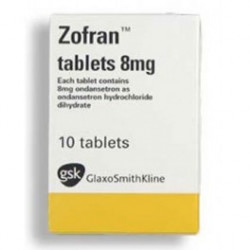Zofran (ondansetron) Coupons, Discounts & Cost
Zofran (ondansetron) is a product from the group of antiemetics. One way to save money on the Zofran retail cost regardless of income and insurance status is to use Zofran coupons or discount cards from RXCoupons. Use this Ondansetron coupon at this online pharmacy and receive up to 75% off the sale price.
What should patients know about Zofran?
Zofran (ondansetron) is a product from the group of antiemetics. Zofran is prescribed to prevent vomiting and nausea caused by cytostatic chemotherapy, radiotherapy, surgical procedures.
Zofran contraindications
Zofran is contraindicated in the following cases: - Pregnancy and lactation; - Hypersensitivity to the components of the drug.
Zofran can be used by women during pregnancy in critical situations. You should consult your doctor if you need to use the drug during lactation.
Zofran suppositories are not used in children. Patients older than 2 years of age can take Zofran syrup and tablets. Zofran tablets are not prescribed to patients suffering from phenylketonuria.
The drug should be prescribed with caution to patients with individual sensitivity to other drugs of the same group, as well as to patients with intestinal obstruction.
Zofran solution for intravenous and intramuscular administration should be used with caution simultaneously with antiarrhythmics and beta-blockers. Patients with heart problems should also use Zofran with caution.
How to take Zofran
Zofran tablets should be swallowed with or without water. As a rule, the adult daily dose is 8-32 mg. It is recommended to use the following regimens:
- Moderately emetogenic cancer chemotherapy and radiotherapy: 8 mg within 1-2 hours before the main therapy. Take the same dose every 12 hours for 1-2 days. - Highly emetogenic cancer chemotherapy: 24 mg within 1-2 hours before the main therapy.
Zofran should be taken 2 times a day (8 mg daily during 5 days) in order to prevent prolonged or late vomiting. Adults should use Zofran in the form of syrup or tablets at a dose of 16 mg 1 hour prior to anesthesia in order to prevent nausea in the postoperative period.
Children should use Zofran injections in a dose of 5 mg/m².
Elderly patients and patients with renal insufficiency may not change the dose. The daily dose of ondansetron for patients with liver disorders should not be more than 8 mg.
Zofran for rectal administration: adults should use 1 suppository within 1-2 hours before chemotherapy or radiotherapy. The drug should be used within 5 days after the end of chemotherapy or radiotherapy.
Zofran side effects
Immune system: rarely - hypersensitivity reactions, anaphylaxis.
Cardiovascular system: chest pain, bradycardia, arrhythmia, low blood pressure.
Digestive system: dry mouth, diarrhea or constipation.
CNS: dizziness, headache, convulsions, motor disorders (including extrapyramidal symptoms such as dystonia, seizures and dyskinesia).
Allergic reactions: bronchospasm, urticaria, laryngospasm, angioedema.
Other reactions: hypercreatininemia, hypokalemia, blurred vision; very rarely - transient vision loss.
Zofran special instructions
Allergic reactions may develop in some patients who have increased sensitivity to ondansetron.
Zofran does not have a sedative effect on patients. Therefore, it does not affect your ability to drive a car.
Care should be taken when using Zofran and the following drugs: rifampicin, carbamazepine, barbiturates, carisoprodol, griseofulvin, phenylbutazone, papaverine, phenytoin, tolbutamide, allopurinol, cimetidine, macrolides, chloramphenicol, valproic acid, diltiazem, disulfiram, sodium valproate, fluconazole, erythromycin, fluoroquinolones, lovastatin, ketoconazole, omeprazole, metronidazole, propranolol, quinine, quinidine, verapamil.
Zofran does not interact with furosemide, temazepam, propofol and tramadol.
Phenytoin, rifampicin and Carbamazepine can reduce the concentration of ondansetron.
Tramadol can reduce the analgesic effect of Zofran.
The drug should be stored out of reach of children. Keep it protected from light, at a temperature of no higher than 30° C.

